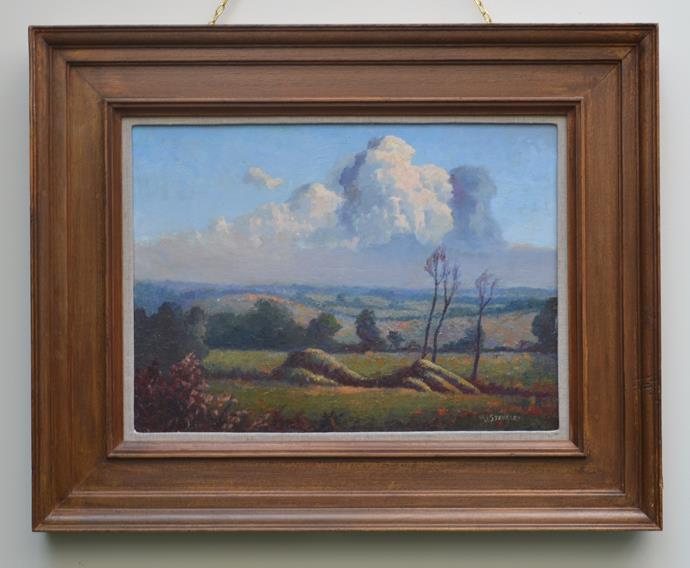Christian Malford Walter Steggles
The Wiltshire landscape - and here it is the small village of Christian Malford - was much frequented by Walter Steggles in the last years of his life, when he lived at Bradford-on-Avon and then Calne. This particular picture has a degree of serenity about it, which suggests long familiarity, a deep attachment. The wider landscape, dominating the centre of the picture, is depicted in just a few measured, horizontal strokes: blue horizon, gently undulating hills highlighted by a touch of golden sunshine, fields framed by trees and hedges. There is a constant reassurance of tranquillity and continuity. Above, however, there is haze - a smooth swathe of pinkish, lavender-grey paint - of atmospheric mist and above that, a towering bank of hectic clouds.
This is wonderful: it reminds me that Luke Howard, an amateur meteorologist, in 1803 published a remarkable volume, On the Modification of Clouds. The terminology he attached to particular cloud formations - cumulus, stratus, cirrus and lots in-between - is still in use today. And, in the 19th century, it proved enormously influential for many artists, notably John Constable and J.M.W. Turner, both of whom became fascinated with the study of clouds, from the 1820s[1]. They understood that different clouds signified different kinds of weather and atmosphere; clouds are ‘indicators’ of the effects of weather, ‘as is the countenance of the state of a person’s mind or body’. British artists have explored the implications of this discovery for the last two centuries. With this in mind – what are we to make of Steggles’ clouds?![2]
One or two of the little, puffy clouds must be described as cumulus (Latin for ‘heap’ or ‘pile’). Familiar, fair weather clouds: but, it is clear that something more threatening is building up – stratocumulus, stark white shaded by dark grey, towering, often presaging a change in the weather. These clouds tend to dissipate in the sunshine of mid-day, but re-form and gather again as the heat declines in the evenings.
There is more. Below the serene, distant Wiltshire landscape - close to the eyeline of the painter and the viewer - is another image of uncertainty, even threat. Two piles of … hay, brash from the ditch, fallen vegetation? Each of the piles, the low sunshine catching their right sides with a cool, silvery light, seems almost alive. Their potential for disruption is emphasised by the three, curiously bare, trees - saplings, dead stems? - emerging from the smaller heap.
There is nothing at all laborious about this picture, yet it offers a powerful recognition that the English landscape is anything but unchanging, perpetually peaceful, always beautiful. Nature is shifting and carries with it the potential to disrupt our lives, to delight and frustrate, to reward and challenge. This is a quality we often find in Steggles’ work and it is worth remembering that, in 1936, when he was still exhibiting with the East London Group, he must have been aware of the hugely popular first International Surrealist Exhibition. I think it must have reinforced that quality that we can read in even his earliest paintings: behind the picture is another, denser, more challenging, more complex and wonderful, life.
[1] Many of Constable’s cloud studies are held by the V&A and Tate Britain accommodates many of Turner’s.
[2] I note that Steggles’ employment was in a ‘shipping firm’. Whatever the lowly role, for anyone working in this context, the state of the weather, signalled not least by the character of cloud formations, must have been a preoccupation.
26.5cms x 37cms
43.5cms x 54cms

